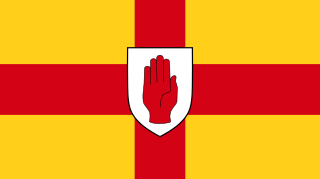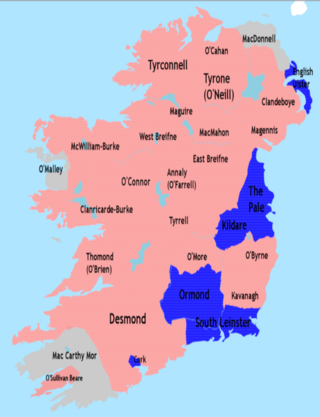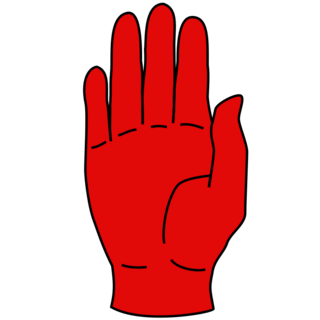Related Research Articles

Ulster is one of the four traditional Irish provinces, in the north of Ireland. It is made up of nine counties: six of these constitute Northern Ireland ; the remaining three are in the Republic of Ireland.
Brian Irvine is a composer from Northern Ireland. His work has been characterized as avant-garde, incorporating elements of "free jazz, rock, rap, thrash, tango, lounge and contemporary classical" music. Irvine was Associate Composer with the Ulster Orchestra (2007–2011) and Professor of Creative Arts at the University of Ulster.
The Ulster Scots, also called Ulster Scots people or Scotch-Irish (Scotch-Airisch), are an ethnic group in Ireland, found mostly in the province of Ulster and to a lesser extent in the rest of Ireland. Their ancestors were mostly Protestant Presbyterian Lowland Scottish colonists, the largest numbers coming from Galloway, Lanarkshire, Renfrewshire, Ayrshire and the Scottish Borders including nearby parts of Northern England, with others coming from further north in the Scottish Lowlands and, to a much lesser extent, from the Highlands.

The Plantation of Ulster was the organised colonisation (plantation) of Ulster – a province of Ireland – by people from Great Britain during the reign of King James VI of Scotland and I of England. Most of the settlers came from southern Scotland and northern England; their culture differed from that of the native Irish. Small privately-funded plantations by wealthy landowners began in 1606, while the official plantation began in 1609. Most of the land colonised was forfeited from the native Gaelic chiefs, several of whom had fled Ireland for mainland Europe in 1607 following the Nine Years' War against English rule. The official plantation comprised an estimated half a million acres (2,000 km²) of arable land in counties Armagh, Cavan, Fermanagh, Tyrone, Tyrconnell and Londonderry. Land in counties Antrim, Down and Monaghan was privately colonised with the king's support.
The Irish Rebellion of 1641 was an uprising by Irish Catholics in the kingdom of Ireland, who wanted an end to anti-Catholic discrimination, greater Irish self-governance, and to partially or fully reverse the plantations of Ireland. They also wanted to prevent a possible invasion or takeover by anti-Catholic English Parliamentarians and Scottish Covenanters, who were defying the king, Charles I. It began as an attempted coup d'état by Catholic gentry and military officers, who tried to seize control of the English administration in Ireland. However, it developed into a widespread rebellion and ethnic conflict with English and Scottish Protestant settlers, leading to Scottish military intervention. The rebels eventually founded the Irish Catholic Confederacy.

The Nine Years' War, sometimes called Tyrone's Rebellion, took place in Ireland from 1593 to 1603. It was fought between an Irish alliance—led mainly by Hugh O'Neill of Tyrone and Hugh Roe O'Donnell of Tyrconnell—against English rule in Ireland, and was a response to the then-ongoing Tudor conquest of Ireland. The war was fought in all parts of the country, but mainly in the northern province of Ulster. The Irish alliance won some important early victories, such as the Battle of Clontibret (1595) and the Battle of the Yellow Ford (1598), but the English won a decisive victory against the alliance and their Spanish allies in the siege of Kinsale (1601–02). The war ended with the Treaty of Mellifont (1603). Many of the defeated northern lords left Ireland to seek support for a new uprising in the Flight of the Earls (1607), never to return. This marked the end of Gaelic Ireland and led to the Plantation of Ulster.

The Tudor conquestof Ireland took place under the Tudor dynasty, which held the Kingdom of England during the 16th century. Following a failed rebellion against the crown by Silken Thomas, the Earl of Kildare, in the 1530s, Henry VIII was declared King of Ireland in 1542 by statute of the Parliament of Ireland, with the aim of restoring such central authority as had been lost throughout the country during the previous two centuries. Several people who helped establish the Plantations of Ireland also played a part later in the early colonisation of North America, particularly a group known as the West Country men.

Plantations in 16th- and 17th-century Ireland involved the confiscation of Irish-owned land by the English Crown and the colonisation of this land with settlers from Great Britain. The Crown saw the plantations as a means of controlling, anglicising and 'civilising' parts of Ireland. The main plantations took place from the 1550s to the 1620s, the biggest of which was the plantation of Ulster. The plantations led to the founding of many towns, demographic and economic changes, changes in land ownership and the landscape, and also to ethnic and sectarian conflict. They took place before and during the earliest English colonisation of the Americas, and a group known as the West Country Men were involved in both Irish and North American colonization.
Scotch-IrishAmericans are American descendants of Ulster Protestants who immigrated from northern Ireland to America during the 18th and 19th centuries, whose ancestors had originally migrated mainly from the Scottish Lowlands and Northern England. In the 2017 American Community Survey, 5.39 million reported Scottish ancestry, an additional 3 million identified more specifically with Scotch-Irish ancestry, and many people who claim "American ancestry" may actually be of Scotch-Irish ancestry.

Belfast Castle is on the slopes of Cavehill Country Park in Belfast, Northern Ireland, in a prominent position 400 feet (120 m) above sea level. Its location provides unobstructed views over the City of Belfast and Belfast Lough. The current castle is a Victorian structure, built between 1867 and 1870. The main entrance into the Belfast Castle Demesne is now where Innisfayle Park meets Downview Park West, just off the Antrim Road. The original main entrance into the demesne was formerly on the Antrim Road itself, where Strathmore Park now meets the Antrim Road.

The Red Hand of Ulster, also known as the Red Hand of Ireland, is an Irish symbol used in heraldry to often denote the Irish province of Ulster in particular, although historically the hand has been used by many Irish clans across the Island. It is an open hand coloured red, with the fingers pointing upwards, the thumb held parallel to the fingers, and the palm facing forward. It is usually shown as a right hand, but is sometimes a left hand, such as in the coats of arms of baronets.

Northern Ireland is divided into six counties, namely: Antrim, Armagh, Down, Fermanagh, Londonderry and Tyrone. Six largely rural administrative counties based on these were among the eight primary local government areas of Northern Ireland from its 1921 creation until 1973. The other two local government areas were the urban county boroughs of Derry and Belfast.

Drumboe Castle was located on the outskirts of Stranorlar, a small town in County Donegal in Ulster, Ireland.
Éogan or Eógan is an early Irish male name, which also has the hypocoristic and diminutive forms Eoganán, Eóghainin, Eóghain and Eóghainn. In more modern forms of Irish it is written as Eóghan or Eoghan (/'oːəun/).
Northern Irish people is a demonym for all people born in Northern Ireland or people who are entitled to reside in Northern Ireland without any restriction on their period of residence. Most Northern Irish people either identify as Northern Irish, Irish or British.
Con(n) MacShane O'Neill (1565–1630) was an Irish flaith or Prince of Ulster, the Lord of Clabbye, nobleman, rebel, and political leader in the late 16th century and early 17th century.
Ulster Protestants are an ethnoreligious group in the Irish province of Ulster, where they make up about 43% of the population. Many Ulster Protestants are descendants of settlers who arrived in the early 17th century Ulster Plantation. This was the colonisation of the Gaelic, Catholic province of Ulster by English-speaking Protestants from Great Britain, mostly from the Scottish Lowlands and Northern England. Many more Scottish Protestant migrants arrived in Ulster in the late 17th century. Those who came from Scotland were mostly Presbyterians, while those from England were mostly Anglicans. There is also a small Methodist community and the Methodist Church in Ireland dates to John Wesley's first visit to Ulster in 1752. Although most Ulster Protestants descend from Lowland Scots and English, some also descend from Irish, Welsh and Huguenots.
Sir Ralph Bingley (c.1570–1627) was a Welsh soldier who served and settled in Ireland.
Sir Arthur O'Neill or Sir Art O'Neill was an Irish soldier and landowner. He was part of the O'Neill dynasty, which was the most powerful Gaelic family in Ireland at the time. He was the son of Turlough Luineach O'Neill, the head of the O'Neill dynasty until 1595. He was the second son of Turlough, but his eldest brother Henry O'Neill died in 1578. At times he had a strained relationship with his father, and offered his support to Turlough's rival Hugh O'Neill, Earl of Tyrone. When Tyrone succeeded Turlough as head of the O'Neills and began Tyrone's Rebellion, Arthur offered tacit support to his distant cousin.
Jac Morgan is a Welsh rugby union player. Morgan plays in the backrow. He plays rugby for the Scarlets.